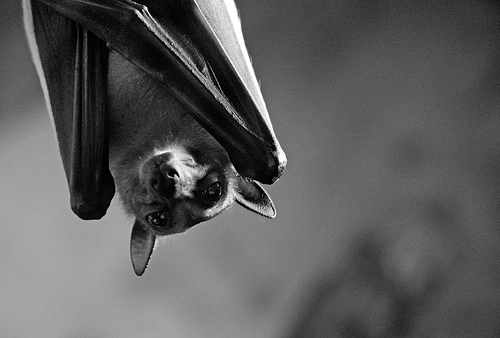Living with Wildlife – Bats
by Ontario SPCA and Humane Society | Wildlife Fact Sheets | April 1, 2019

In an effort to coexist with wildlife, consider the enormous hardships these intelligent and fascinating wild species encounter because so much of their habitat has been destroyed. Each year they are forced into closer contact with humans and must compete with us for food, shelter and space. With a little understanding, patience and a few precautions and common sense steps, we can all enjoy the wonderfully interesting wild animals who share our backyards and cities.
There are eight different species of bats that live in Ontario – the most common of these is the “little brown bat.” The bat is the only mammal who is able to fly. This unique ability is one of many characteristics that make these animals a fascinating and important part of our ecosystem.
Habitat
Bats normally roost in trees or caves but due to urbanization bats can often be found roosting in man-made structures, especially attics. This is the primary reason that bats come into conflict with people. The bats living in Ontario migrate or hibernate during the winter months.
Diet
Bats are nocturnal and hunt for food while in flight. The typical diet of bats in Ontario consists of insects, mainly mosquitoes. Bats can catch 600 to 1000 mosquitoes per hour, and are important contributors to keeping the insect population under control. It is a myth that bats are blind, however, they do use high-frequency sounds as their main method of communication and navigation. This system of echolocation allows them to detect their prey and dodge obstacles while in flight at night.
Reproduction
Bats mate in the fall but do not give birth until May. Bats typically have one “pup” per year and the young are dependent upon their parents for several weeks before they are able to fly on their own.
Common questions:
There is a bat(s) in my attic. What should I do?
Due to the small size of bats they are able to gain entry to an attic through a hole as small as a half-inch. This can make it difficult to find all possible entry/exit sites used by the bat(s), but it is important to investigate thoroughly and find all the access points if possible. Firstly, conduct a “bat watch.” Go outside about 30 minutes before dusk and watch for bats leaving the attic. Watch closely until about 30 minutes after dusk. Once you have spotted the entry/exit hole(s) you may begin steps to exclude the bats from your attic. However, do not begin exclusion during the months of May to August, or you may trap young inside that will die.
The best time to exclude bats is the fall when they are looking for other roosting sites for hibernating. Install one-way doors over the entry/exit holes. This allows bats to leave the attic but not return. You can also try placing netting over the hole that extends 18 to 24 centimeters from the entry/exit hole. Secure the top and sides of the net but leave the bottom open. This system will allow the bats to exit the attic, but will prevent them from re-entering. Leave the netting and one-way doors in place for several days, then check the attic for signs of bats and conduct another “bat watch.” When you are certain there are no more bats remaining in the attic you can permanently seal the entry/exit holes.
There is a bat in my bedroom/living room/kitchen/etc. What should I do?
If a bat is found in a living space of the house where direct contact, such as a bite, may have been possible, contact your public health authorities to assess exposure risk. The Ontario SPCA does not recommend that members of the public attempt to capture and confine bats. For information on this matter, contact your municipal animal services office or your local public health department.
IF YOU ARE BITTEN BY A BAT YOU MUST IMMEDIATELY WASH THE BITE AREA WITH SOAP AND WATER AND CALL PUBLIC HEALTH, OR GO TO THE DOCTOR/HOSPITAL.
A bat flew into my house through an open door or window. What should I do?
If a bat has flown into your house through an open door or window and there has been no direct contact between the bat and humans in the house, simply close all doors leading further inside the house and open the door or window that directly leads to the outside and the bat should fly out.
EXCLUSION IS THE ONLY PERMANENT AND HUMANE SOLUTION FOR A BAT PROBLEM. For diagrams and step-by-step directions for exclusion methods, as well as general information about bats, you can visit www.batcon.org.
Categories
Testimonial
I stand behind SPCA with my monthly gift
I stand behind SPCA with my monthly gift. I am so happy there are folks like you to care for those who can’t help themselves. My family and I have had animals all our lives and know what a comfort they are. Thank you SPCA.
